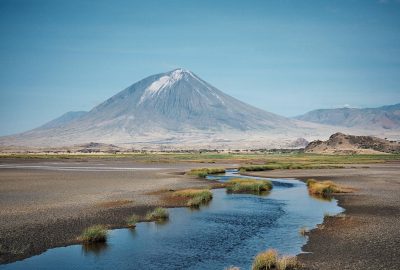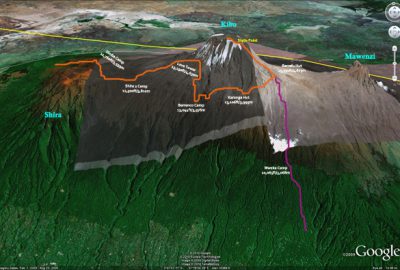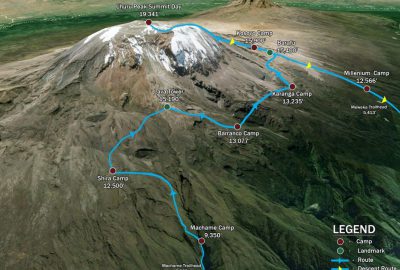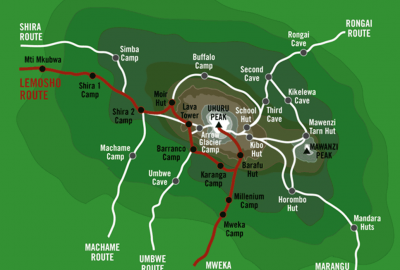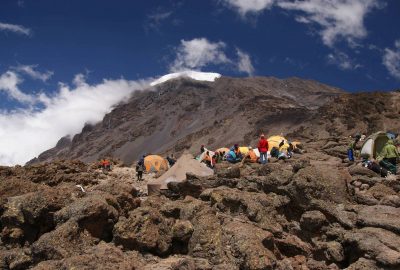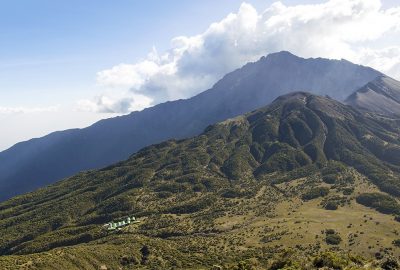For mountain climbing, Tanzania has two main attractions; Mt. Kilimanjaro and Mt. Meru. Mt Kilimanjaro of course is the most famous. Just 3° south of the equator, Kilimanjaro’s white flat top, shimmers in the blue sky. Grand and majestic, it looks “as wide as all the world, great, high, and amazing white in the sun” as Hemingway had described it. It has the distinction of being highest freestanding mountain in the world (compare with nearby Moshi town with an elevation of 900m/2,953ft), the highest summit in Africa (5895m/19,340ft) and the highest mountain in the world that can be climbed without technical equipment and techniques. There are several route choices outlined in the next few pages of this website. A Kilimanjaro climb can be accomplished in as few as 5 days but taking longer leads to a higher success rate. Conquering Mt. Kilimanjaro is mostly a matter of fitness and determination mixed in with how well your body adjusts to the high altitude. Our staff is well trained in recognizing signs of Acute Mountain Sickness (AMS), the biggest enemy to a successful summit. Your health will be expertly monitored along the way. By listening to your guides and heeding their advice, you will have the greatest opportunity for a successful and healthy climb. Over the course of a few days, you will pass through several climate zones, from equatorial rain forests surrounded by banana and coffee plantations to near arctic conditions. This makes packing the right layers vital. Make sure you follow our packing list. Note that items can be rented locally.
Fitness preparation for climbing Kilimanjaro
How fit do you need to be to climb Kilimanjaro?
While it is always good to get fit, there’s no need to go overboard with fitness preparations for climbing Kilimanjaro. Some guidebooks and websites go into extraordinary detail about fitness regimes. I, however, along with most of the guides and, indeed, the majority of trekkers who have climbed Kili all think that most of these regimes are unnecessary. Why? Simply because the main reason why people fail to reach the summit is due to altitude sickness rather than lack of necessary strength or stamina.
That said, the fitter you are, the more enjoyable your trek up Kilimanjaro. And It’s true that some do, indeed, fail through sheer lack of fitness, strength and stamina.
After all, on the final push to the summit you will be walking at very high altitude for about 16 hours! So a certain degree of fitness is necessary. So anything you can do in the way of training can only help.
Whatever the fitness regime you decide to follow, a few days of walking at some point would be a good thing to do; it won’t improve your fitness to a great degree but it will at least confirm that you can walk for more than a few hours at a time, and for more than one day. Wear the clothes you plan to bring to Kilimanjaro with you – particularly your boots and socks – and carry the day pack that you hope to be carrying all the way to the top of Kibo too.
One more thing: if you’re planning on relying on it on Kilimanjaro, try Diamox before you go to make sure it has no severe adverse reaction on you.The mental challenge of climbing Kilimanjaro Just as important as getting yourself physically prepared for climbing Kilimanjaro, you also need to get yourself mentally ready for the challenge too. Because if altitude sickness is the number one reason why people fail to get to the top of the Roof of Africa, then in my experience the second most common reason for failure is that people just are not ready for the hardships.
In other words, it’s not altitude sickness that’s stopping them from getting to the summit – it’s altitude sickness.

So be warned that a lot of the challenge of climbing Kilimanjaro is mental. It’s cold up there, and you may at times feel terrible too (headaches, nausea and loss of appetite are just three of the symptoms most climbers will suffer at some point during their trek). IT may be hammering down with rain for days on end, you’re soaked through, miles from camp and not enjoying the experience at all.
It’s at times like that when you’ll need to dig deep, remind yourself why you’re doing this, what made you decide to climb in the first place, how much money you have spent in getting this far, and how you’ll feel if you do give up now. Remind yourself, too, that the weather does change quickly on Kilimanjaro; that while it may be tough now, things will get better.
You just need to be patient, and keep going.
So prepare yourself for some tough hours when you may want to give up. Overcome those and, as long as you have acclimatised properly, there’s no reason why you should not get to the top of Africa’s Highest Mountain too.
KILIMANJARO ROUTES
7 Days
6 Days
7 Days
6 Days
6 Days
7 Days
6 Days

